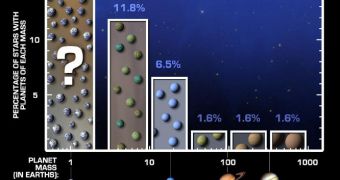A group of investigators from the American space agency and a university has determined that the number of theoretically-possible, Earth-like planets in the Universe is a lot larger than initially estimated.
The researchers show that as many as 25 percent of all Sun-like stars may have exoplanets similar to Earth orbiting them. The work was funded by NASA and the University of California.
The investigation took five years to complete and, during this time, scientists analyzed some 166 Sun-like stars in our galactic neighborhood, in search for any kind of planets they may keep around.
Using the Hawaii-based W.M. Keck Observatory, the team investigated these stars for signs of planets ranging in weight from 3 to more than 1,000 Earth masses. This is the most extensive exoplanetary survey of its type.
Throughout our galaxy the Milky Way, the astronomers say, it may be that smaller extrasolar planets are a lot more common than larger, Jupiter-class ones, based on the results of this analysis.
“We studied planets of many masses – like counting boulders, rocks and pebbles in a canyon – and found more rocks than boulders, and more pebbles than rock,” explains study expert Andrew Howard.
“Our ground-based technology can't see the grains of sand, the Earth-size planets, but we can estimate their numbers,” adds the investigator, who was the lead author of the new research.
“Earth-size planets in our galaxy are like grains of sand sprinkled on a beach – they are everywhere,” adds Howard, who is based at the University of California in Berkeley (UCB).
The main conclusion of the new study is therefore that potentially habitable worlds may in fact be common throughout our galaxy. Details of the work appear in the October 29 issue of the top journal Science.
“During planet formation, small bodies similar to asteroids and comets stick together, eventually growing to Earth-size and beyond,” Howard goes on to say.
“Not all of the planets grow large enough to become giant planets like Saturn and Jupiter. It's natural for lots of these building blocks, the small planets, to be left over in this process,” the expert adds.
According to the new data, more than 46 billion Earth-size planets exist around the 200 billion stars in our galaxy.
“This work is part of a key NASA science program and will stimulate new theories to explain the significance and impact of these findings,” adds Mario R. Perez, who is a Keck program scientist at the NASA Headquarters, in Washington DC.

 14 DAY TRIAL //
14 DAY TRIAL //